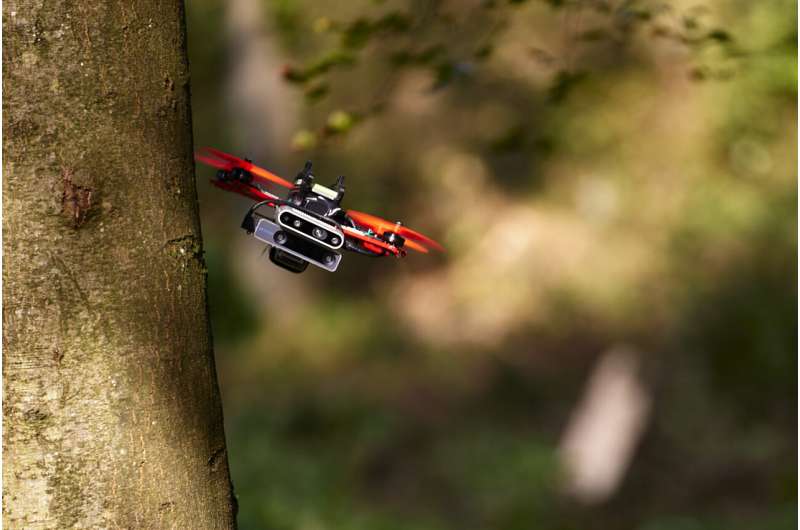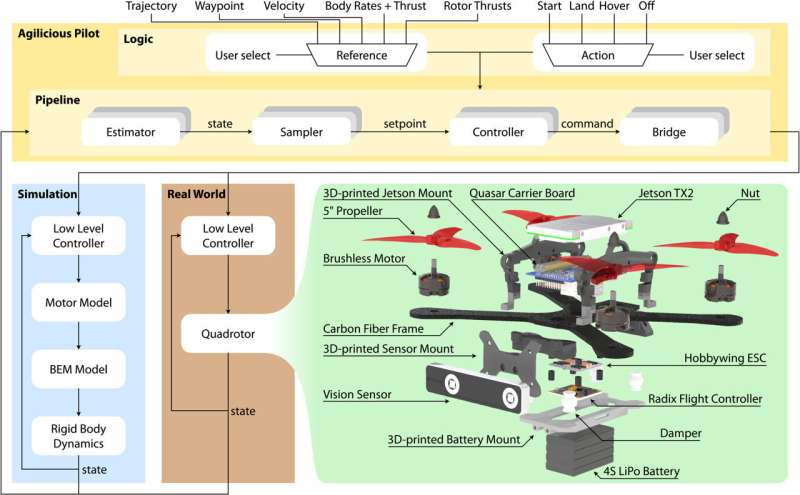Credit: Robotics and Perception Group
A team of researchers at the University of Zurich, has developed a highly agile quadrotor drone that is able to avoid obstacles and carry out trajectory tracking. In their paper published in the journal Science Robotics, the group describes how they designed their drone, what they put into it and how well it worked when tested.
Quadrotor drones can be very agile fliers, most particularly when they have a human pilot guiding their movements. Autonomous quadrotors, on the other hand, have suffered from agility issues, particularly when traveling at high speeds. In this new effort, the team in Switzerland has improved the agility of a quadrotor drone with their new design built using a variety of technologies.
Credit: Science Robotics (2022). DOI: 10.1126/scirobotics.abl6259
The new design involved adding onboard vision sensors, monitoring systems for flight control and a host of other components meant to improve the ability of the drone to receive and process flight information in real time. They also added an advanced AI module, NVIDIA Jetson TX2—one that is able to carry out complex tasks supporting the drone's hardware quickly enough to allow for smooth agile flight.
The researchers tested their drone under a wide range of flights, from slow and steady, to full speed to obstacle avoidance. They found their drone capable of maintaining agility at speeds ranging from 50 to 70 kph. They also found it could conduct motion-capture trajectory tracking, where the drone continuously observes its position in the air and adds time instances to show where it is and when. They also tested its use in virtual reality simulations. And they also noted, that the system was able to learn as it went and because of that its performance improved over time.
In looking at the results of their testing, the researchers found that their drone outperformed other systems in both agility and obstacle tracking and avoidance. They suggest its performance raises it to the degree that it could be used for time-sensitive real-world missions, such as search and rescue operations and perhaps delivery of goods. The team has also made both the software and hardware open source, allowing anyone who wishes to use their design to do so.
The Agilicious software and hardware quadrotor platform are tailored for agile flight while featuring powerful onboard compute capabilities through an NVIDIA Jetson TX2. The versatile sensor mount allows for rapid prototyping with a wide set of monocular or stereo camera sensors. As a key feature, the software of Agilicious is built in a modular fashion, allowing rapid software prototyping in simulation and seamless transition to real-world experiments. The Agilicious Pilot encapsulates all logic required for agile flight while exposing a rich set of interfaces to the user, from high-level pose commands to direct motor commands. The software stack can be used in conjunction with a custom modular simulator that supports highly accurate aerodynamics based on BEM or with RotorS, hardware-in-the-loop, and rendering engines such as Flightmare. Deployment on the physical platform only requires selecting a different bridge and a sensor-compatible estimator. Credit: Science Robotics (2022). DOI: 10.1126/scirobotics.abl6259
More information: Philipp Foehn et al, Agilicious: Open-source and open-hardware agile quadrotor for vision-based flight, Science Robotics (2022). DOI: 10.1126/scirobotics.abl6259
Journal information: Science Robotics
© 2022 Science X Network

























